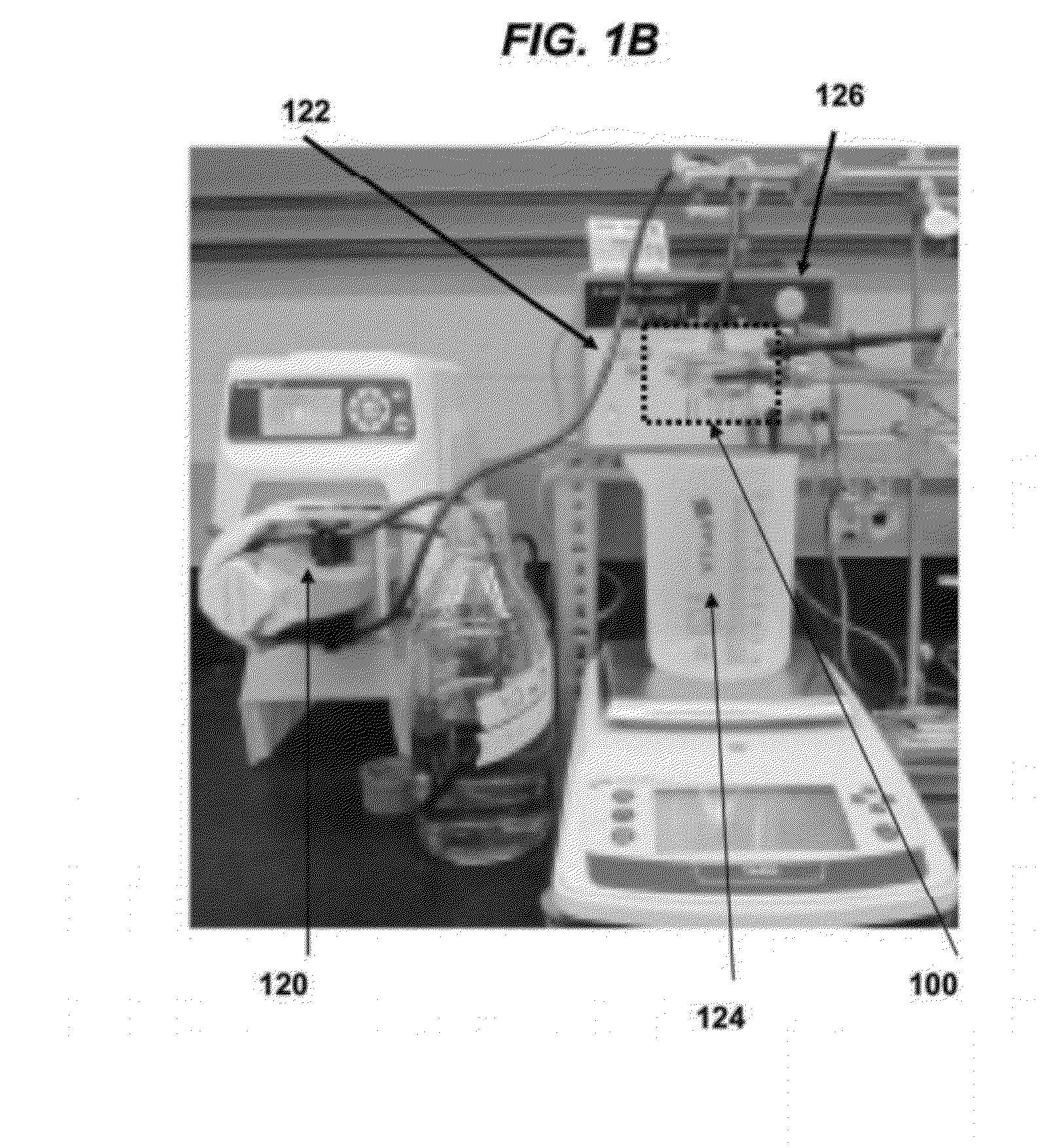Electrochemical carbon nanotube filter and method
a carbon nanotube and filter technology, applied in the field of filtration apparatuses, can solve the problems of unsuitable drinking water, large specific surface area of porous elemental carbon anodes, and inability to efficiently perform electrochemical processes, and achieve the effect of reducing the resistance to flow
- Summary
- Abstract
- Description
- Claims
- Application Information
AI Technical Summary
Benefits of technology
Problems solved by technology
Method used
Image
Examples
example 1
Design and Operation of the Electrochemical Filter
[0372]FIGS. 1A to 1G show images of one embodiment of the electrochemical filtration apparatus and set-up. A commercial 47 mm polycarbonate filtration casing (Whatman) as shown in FIG. 1C was modified to allow for simultaneous electrochemistry. Two holes were drilled in the upper piece of the filtration casing as openings for the cathodic and anodic leads. The main components of the electrochemical filter casing are the perforated stainless steel cathode (1) separated with an insulating silicone rubber seal (2) from the titanium (Ti) anodic ring-connector (3) (FIG. 1D). When the filtration casing is sealed, the anodic Ti ring (3) is pressed into the carbon nanotube filter (4) (FIG. 1E) for electrical connectivity. FIGS. 1F and 1G show images of the MWNT filters mats prior to and after electrochemical filtration, respectively.
[0373]FIG. 2A to 2F show both aerial and cross-section SEM images of the MWNT filter. The MWNT mat is composed...
example 2
Dye Adsorption to the MWNT Filter in the Absence of an Applied Voltage
[0375]FIG. 4A shows a schematic diagram of dye adsorption to the MWNT filter and FIG. 4B shows the methylene blue (MB) adsorption breakthrough curve, [MB]eff / [MB]in vs. t, in the absence of electrochemistry for three MWNT filters of varying physical dimensions ([MB]in=7.0±1.0 μM, [NaCl]in=10 mM, J=1.5±0.1 mL min−1). The squares, circles, and triangles represent filters having average height (h) and diameter (d) of h=41 μm and d=30 mm, h=68 μm and d=30 mm, and h=41 μm and d=40 mm, respectively. In all cases, the methylene blue concentration of the output fluid was below the limit of detection prior to breakthrough, indicating that all MB molecules had at least one collision that could result in sorption with the MWNT surface during a single pass through the filter of ≦1.2 s. Images of the filtration set-up during the MB adsorption process are shown in FIG. 5. The MB sorption capacities of the three filters were 28....
example 3
Electrochemical Desorption and / or Oxidation of Adsorbed Dye
[0378]Due to the thin film nature of the filter, the total adsorptive capacity of the MWNT filter is relatively low, i.e., dye breakthrough occurs in eff / [MB]in>1, suggesting that the adsorbed MB is electrostatically desorbed. Without wishing to be bound by theory, anodic operation of the MWNT filter can result in accumulation of positively charged holes at the anode surface and / or generation of protons near the MWNT interface. Accordingly, positively-charged methylene blue at the unbuffered pH 6.3 used for the experiments described herein can be electrostatically desorbed. The increase in MB concentration of the output fluid was correlated with the applied potential, i.e., [MB]eff / [MB]in at about 3 volts=˜20)>[MB]eff / [MB]in at about 2 volts=˜6)>[MB]eff / [MB]in at about 1 volt=˜2), which is consistent with an electrostatic desorption mechanism. In all cases, upon continued electrolysis, the [MB]eff / [MB]in quickly decreased un...
PUM
| Property | Measurement | Unit |
|---|---|---|
| Fraction | aaaaa | aaaaa |
| Pore size | aaaaa | aaaaa |
| Pore size | aaaaa | aaaaa |
Abstract
Description
Claims
Application Information
 Login to View More
Login to View More - R&D
- Intellectual Property
- Life Sciences
- Materials
- Tech Scout
- Unparalleled Data Quality
- Higher Quality Content
- 60% Fewer Hallucinations
Browse by: Latest US Patents, China's latest patents, Technical Efficacy Thesaurus, Application Domain, Technology Topic, Popular Technical Reports.
© 2025 PatSnap. All rights reserved.Legal|Privacy policy|Modern Slavery Act Transparency Statement|Sitemap|About US| Contact US: help@patsnap.com



